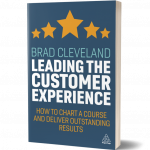“75% of customer experience initiatives fail!” That’s a sensational headline. And one, even with a modest search of cases and literature, you’ll see often (in fact, estimates go as high as 93 percent). My question is, if your focus on customer experience fails, what’s the alternative? Not focusing on customer experience? That just doesn’t make sense. Really, your organization has no choice but to ensure that you’re focused on customer experience, and that it succeeds.
 Now, there are some tough situations—and you might be part of one. Leaders in some organizations don’t prioritize CX and won’t invest in it. Their focus is on revenue, strategic acquisitions, or other priorities. Even more challenging, in my opinion, are those cases where CX is given lip service but provided little support. They say the right things but don’t back it up. If you are part of such an organization, I understand. You are fighting the good fight! My encouragement is to hang in there. Continue to make your case. Ultimately, your focus on customer experience will prevail.
Now, there are some tough situations—and you might be part of one. Leaders in some organizations don’t prioritize CX and won’t invest in it. Their focus is on revenue, strategic acquisitions, or other priorities. Even more challenging, in my opinion, are those cases where CX is given lip service but provided little support. They say the right things but don’t back it up. If you are part of such an organization, I understand. You are fighting the good fight! My encouragement is to hang in there. Continue to make your case. Ultimately, your focus on customer experience will prevail.
Even in the most favorable environments, customer experience can be misunderstood or underappreciated. I want to put my hand up here and make a few friendly recommendations. One is to set the right expectations. Often, the hardest part of a transformation as big as customer experience is simply deciding how to get started. That can be true whether you are a CEO who is spearheading an experience management initiative for 20,000 people, or a customer service team leader who is looking to kindle a flame in a team of four. My encouragement is to establish the expectation that customer experience takes time—in fact, it doesn’t have a finish line. It’s an ongoing transformation that will shape who you are as an organization, and how you operate.
Also, the words you use when you talk about customer experience are important. It’s not a program and shouldn’t be called one. A program or project implies a short-term effort with a finish line. I use the term initiative, but depending on who you’re talking to, even that can be misleading. Words such as transformation, movement, culture shift, and even revolution can help set realistic expectations with colleagues and employees.
Don’t expect others to jump on board without a good reason to do so. An important part of launching this journey is to crystallize why customer experience transformation is so important. This can’t be another run-of-the-mill project that employees can hunker down and wait out until the next initiative comes along.
And one more word to the wise: find allies to stand with you. The reality is, even a CEO can’t do the work of customer experience alone. Think about other leaders around you who have a natural propensity toward customer experience, and get them on board as soon as possible.
Fortunately, it’s quite easy to create a compelling case for CX. Organizations who are doing customer experience well are winning over customers and acquiring market share. Laggards are in danger of extinction. By setting clear expectations and establishing a strong roadmap, your chances of success are exponentially higher.
In time, you’ll see the fruits of your efforts. Results will likely include improvements in revenue, market share, customer and employee engagement, new efficiencies, and others—the BIG things you’re really after. In every case I’ve seen and every company I’ve worked with, the enthusiasm that customers have about your organization is the ultimate measure of how effective your approach is. That enthusiasm pays big dividends.
 Excerpt from Leading the Customer Experience: How to Chart a Course and Deliver Outstanding Results by Brad Cleveland.
Excerpt from Leading the Customer Experience: How to Chart a Course and Deliver Outstanding Results by Brad Cleveland.